My Tiny Slipcover Workroom + Tips for Flourishing in a Small Space
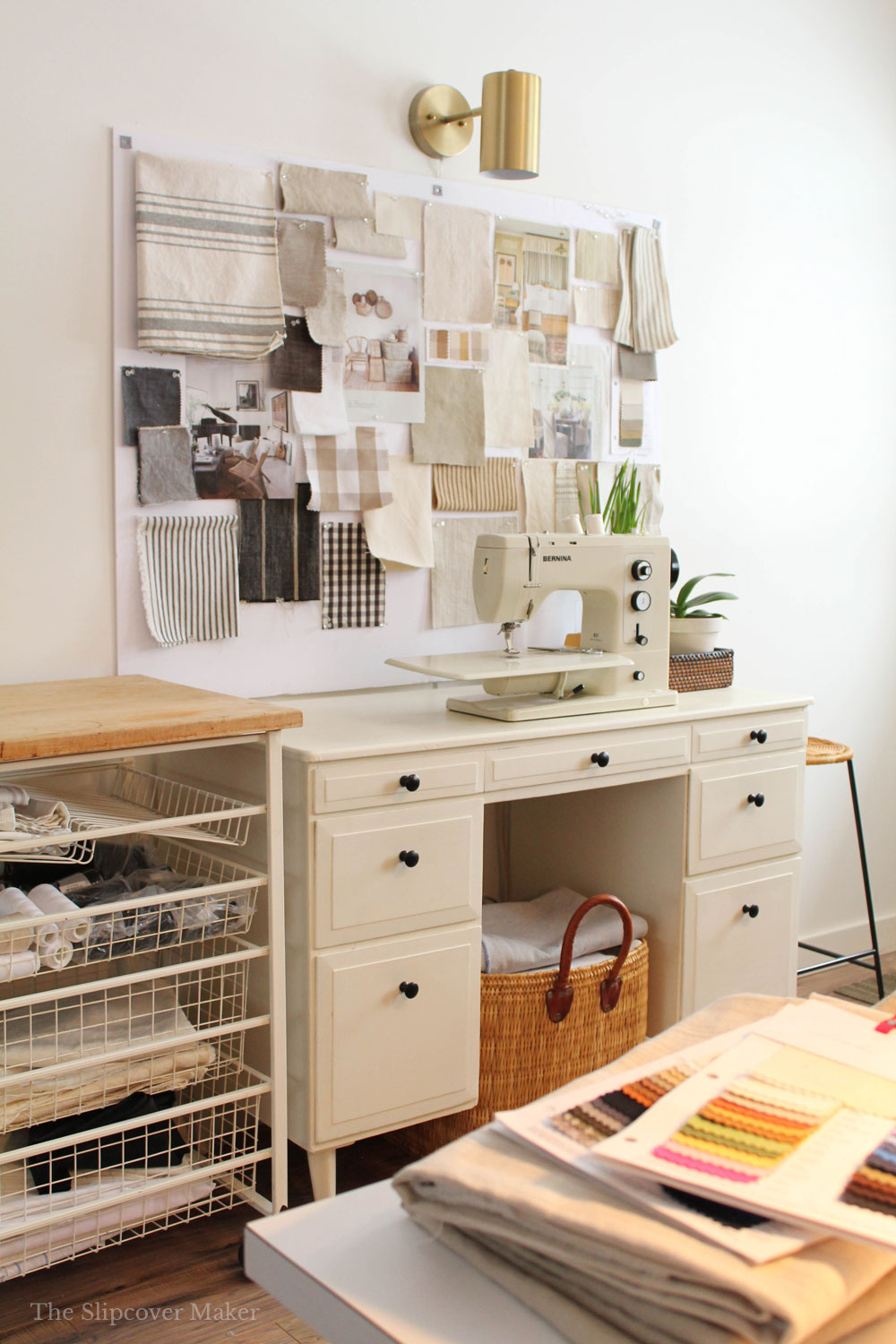
Cheers everyone, happy new year! It sure feels good to turn the page to 2021, doesn’t it? I’m ready to reorganize, reinvent and renew!
If you’re feeling the same way, today’s post just might inspire a new beginning for you. Especially if you’ve been mulling over the idea of starting a slipcover business, or other sewing service from your home but don’t think you have enough room.
Come take a tour of my little workroom and see for yourself how it’s possible to flourish in such a small space.
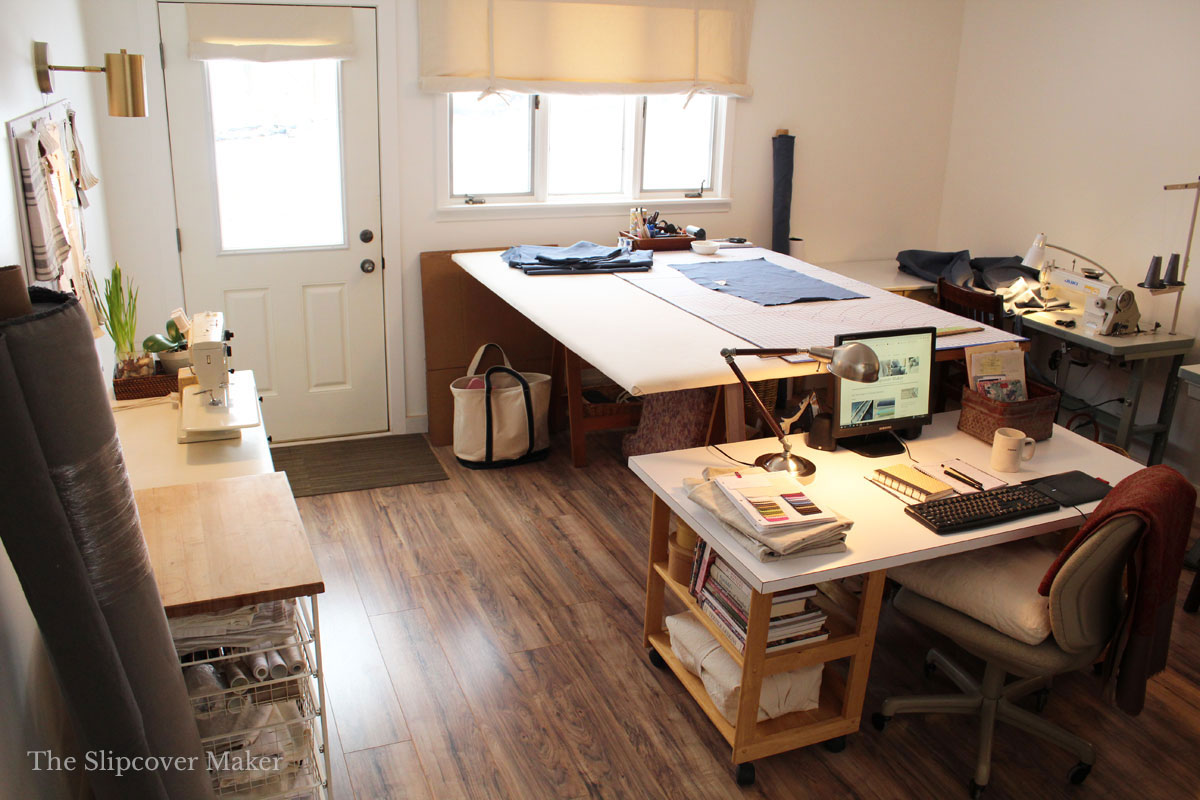
Size: I reside in a small live/work space. The area designated for my slipcover business is only 12 feet x 14 feet. My living area is even smaller, and there is no chance of expanding!
This compact footprint suites the type of services I offer, and my simple lifestyle. It allows me to keep my overhead costs low as my business continues to grow.
1.Design your business to fit your current space.
The slipcover business model I chose doesn’t require a lot of square footage to flourish.
I’m able to produce a lot of slipcovers in my little workroom, and still have plenty of space to carry out related activities: marketing, administrative tasks, blogging, publishing ebooks, photographing my work, and everything else that comes with the job.
I can even do pin fittings here if I choose. Small chairs, ottomans, and cushions only. Larger pieces can be pinned at customers’ homes.
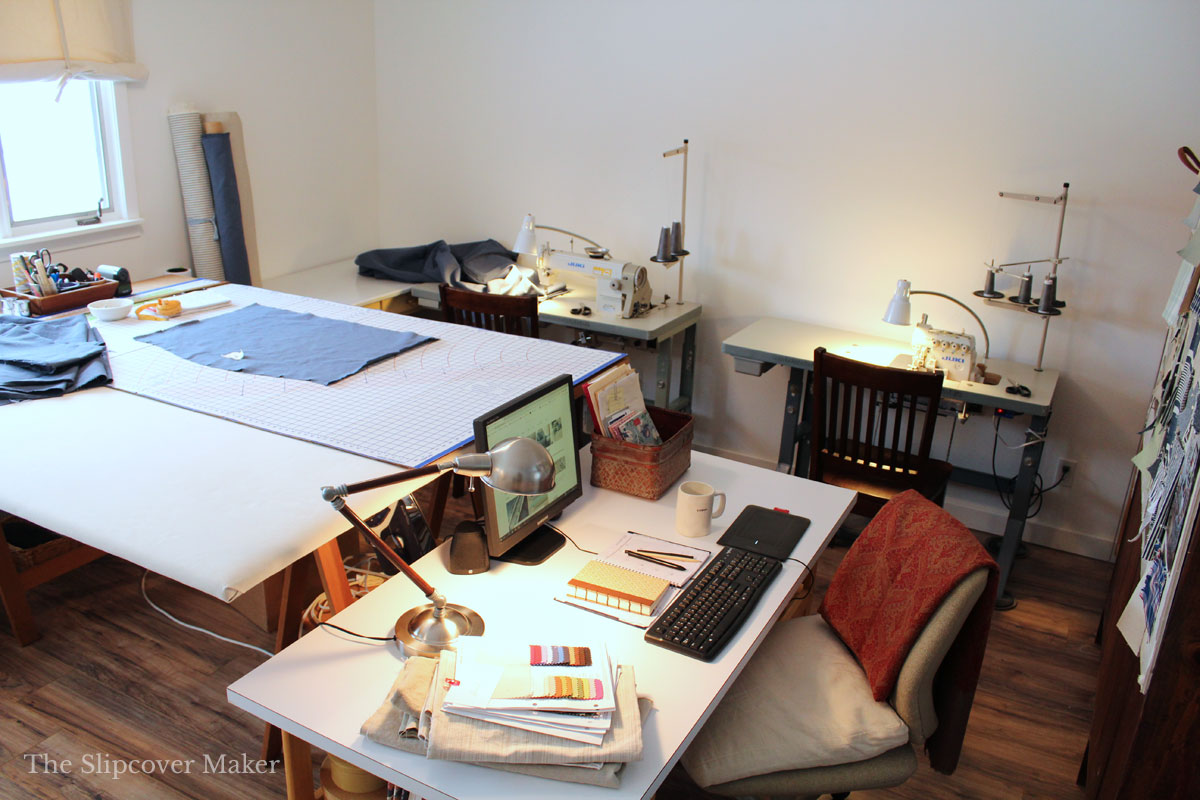
Layout: You really don’t need a lot of furniture and equipment to run a slipcover business out of your home. But you do have to consider the size of each piece, and come up with a smart layout.
For the type of work I do, I only need these pieces.
- A large cutting / pressing table, 60″ W x 80″ L x 37.5″ H
- Two industrial sewing machines
- A computer desk, 60″ L x 30″ W
- A shelving unit and storage drawers
I also use my portable Bernina home sewing machine. I set it up occasionally to sew button holes, and topstitch details. When I’m done, I store it out of the way. It’s more of a mascot than a necessity. 🙂
2. Configure an efficient & flexible layout to maximize space.
I designed my layout in zones: pin fitting, cutting/pressing, sewing and computer work. Super efficient.
Each piece of furniture I use is sized for my small space, has dual purpose, and is easy to set-up, take down, and move around if I ever need to reconfigure my layout. Very flexible.
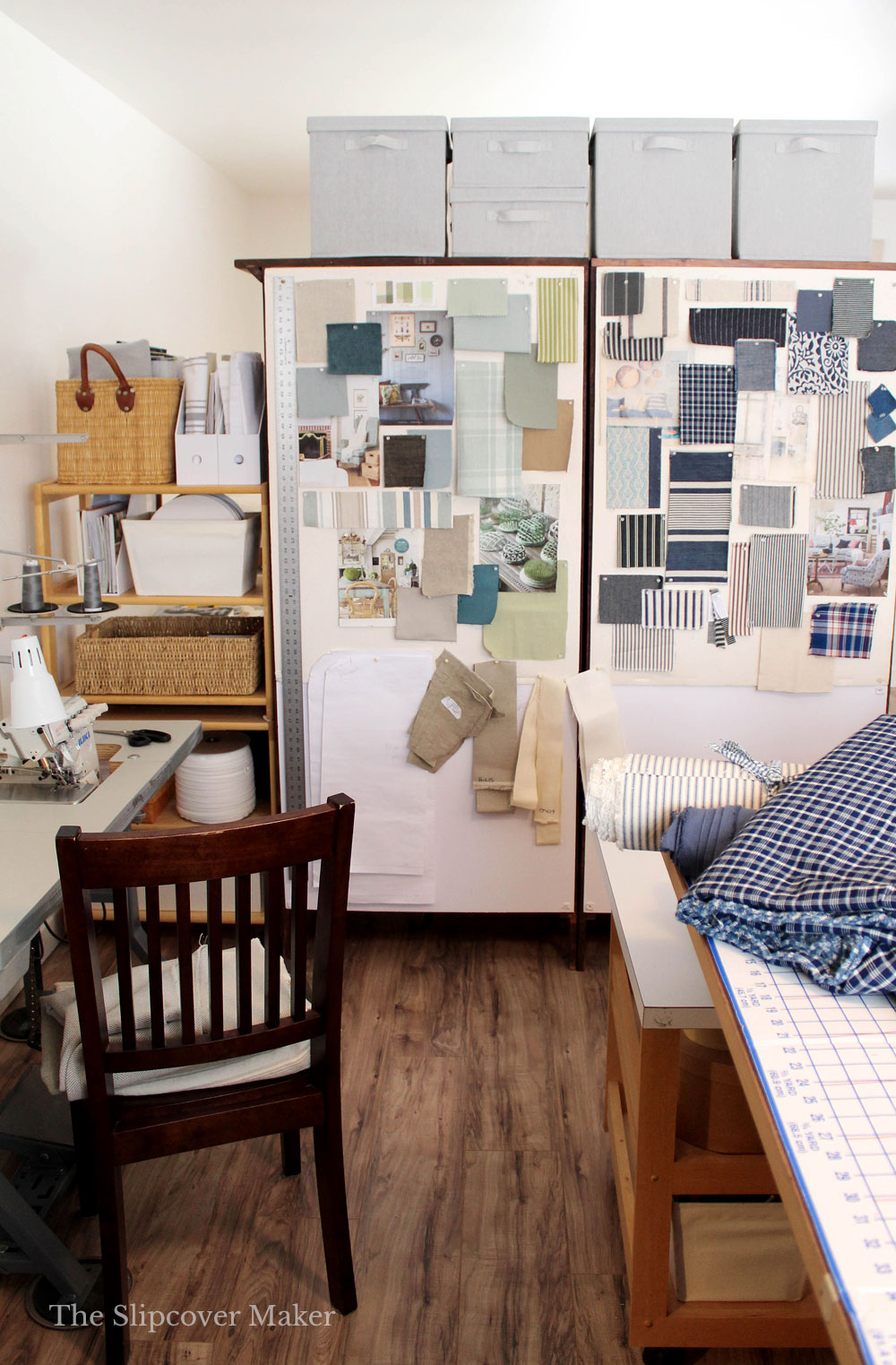
Storage: Thread, Velcro, zippers, welt cord, skirt lining, fabric, scissors, measuring tapes, pins, rulers, pencils, chalk, magazines and office essentials are just some of the tools, materials and supplies used in a slipcover workroom. It’s a big list!
When space is limited it can be challenging to come up with practical storage solutions that are not underfoot.
3. Organize & store essentials around the peripheral of your space to keep your work area clutter free.
My workroom doesn’t have any closets. That’s why I chose furniture that has some kind of built in storage capability. Small items are easy to access and stay out of the way.
Now, I’m not saying my space stays spotless when I’m working on a project. It get’s messy in here!
That’s all the more reason to keep items stored in their places until needed. Tripping over boxes and piles of stuff scattered across the floor when you’re trying to meet a deadline is not fun.
I also don’t overstock supplies. I buy in quantity but only what will fit in my allocated storage.
For tall fabric rolls and big bags of fiber fill I set up a small, protective storage area in my garage. I bring in only what I need for the project I’m working on.

Well, I could go on and on. There are so many other ways your slipcover business can flourish in a small space.
For now, I hope these tips, and pics plant a few seeds for starting your own home based business workroom.
Don’t let limited space hold you back from pursuing your creative endeavor. Take over a second bedroom, a corner of your basement, or even your dining room! I know, I know — easier said than done. But it is possible with thoughtful planning and determination. You can turn a tiny workroom into a thriving business.
Whether you’re ready to launch, or still exploring, don’t forget — I wrote an ebook for you, The Slipcover Maker’s Business Guidebook. I think you will find the step-by-step guidance very helpful.
I wish you all a healthy and happy new year! — Karen
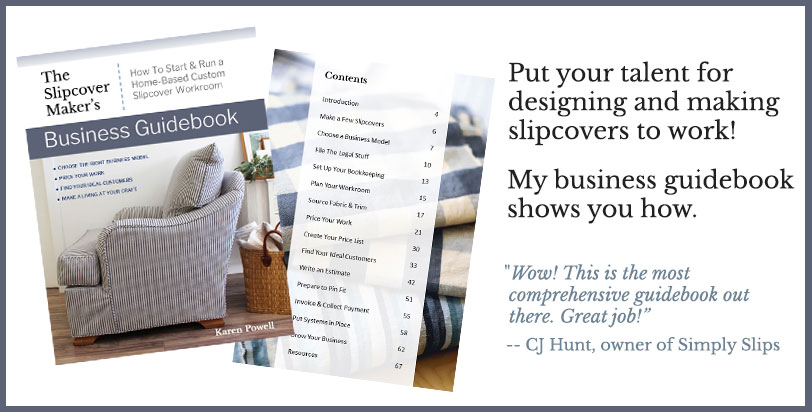
Very Interesting! You have really a well thought out space, it looks very functional.
Could you tell me if you know of any slipcover makers in the Gulf Shores, AL or Pensacola, FL area? I have some slipcovers that need to be replaced. Thanks in advance.
Diane C.
That’s some magic you produce in such a modest space. It is quite lovely, too.
Ester, thank you! In this day and age of bigger and more, I happily thrive in small and sustainable.
I recentl started trying to make coves to sell. My dear friend gifted me a sewing machine and serger. I have been studying and practicing. Ive always wanted to do this. Im taking your post as an encouragement to keep trying. Thank you for your post!
Patsy, I’m cheering you on!! Hang in there. Your work will get easier as you practice and find more efficient ways of running your business. Wishing you much success!
Hi Karen, It is so inspirational seeing your workspace! You are so talented! I am organizing too and it seems gruesome work. I am not sure why. I guess it is just too much stuff in a small space. Your post gave me the inspiration to get more done today – a grey day outside so good to stay in. My goal is to be ready for a wonderful reawakening in the spring and having a dinner party! Thanks, Nan
Nan, Your vision to host a dinner party in the spring sounds like a fantastic incentive to get your small space organized! You can do it. I bet when you are finished your space will not only feel good but look beautiful. Carry on!
Well thought out and organized workroom. Your work is beautiful so it must be a perfect set up. I have a portable Bernina I have had for maybe 45 years!!! Hard to believe, maybe less but not much. It still runs perfectly, never fails. I have sewed an unbelievable amount of things on it. Thank you for sharing your personal work space.
My Bernina 831 is the same age! And, it’s still works great. Aren’t they amazing machines? So well built. I never have problems with mine. I used it to make nearly all of my clothes in the 70’s and home decor items in the 80’s. I appreciate you reading! Best wishes, Paula.
What a great & timely article. After the chaotic complete, drop & run way things were this holiday season I’m ready to revamp my small workroom. Thanks for the inspiration!💗
You’re welcome, Katy! Thanks for reading and happy revamping!
Karen, you have made an efficient workspace!! It is amazing the amount of work you have produced in your workroom! I use zones in my indoor workshop too. One addition I would love to make is an industrial sewing machine! Maybe this year😊😊
Hi Cindy! Ohhhh, an industrial machine would make your workroom complete!
Karen, What a beautiful efficient workspace! You always amaze and inspire me. I need to clean up and reorganize my shop. Happy New Year from your friend in Washington State!
Thank you so much, Karen and Happy New Year! I look forward to seeing more lovely projects coming out of your shop this year.